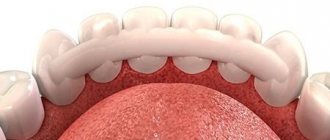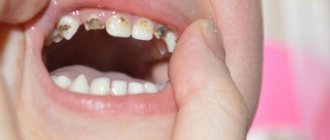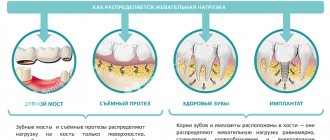For cable-stayed splinting, a high-strength thread is used to connect the teeth together in a tense state. Grooves are prepared along the perimeter of the teeth, through which the thread is sealed with a composite material. When choosing a thread, attention is paid to such characteristics as tensile strength, adhesion to the composite, and minimum thickness (for ease of passage between teeth). It is important that it has a color close to the color of the tooth, which simplifies camouflage.
A reinforcing thread is included in the splint in order to strengthen the connection of teeth with composites. Before polymerization, the thread is stretched as much as possible, so the splinted teeth acquire greater stability. According to laboratory and clinical tests, the strength of the tire increases by 2-3 times.
Splinting requirements
Splinting is performed correctly under the following conditions:
- tooth mobility is limited in all directions;
- the splint provides high strength and reliable fixation to the teeth;
- it has a minimal traumatic effect on the marginal periodontium and hard tissues;
- provides free access to the periodontal sulcus;
- there are no retention points in the design where food could accumulate;
- a harmonious functional occlusion has been formed;
- the tire looks aesthetically pleasing and is capable of transformation and restoration.
Splinting teeth: price 2022
How much does teeth splinting cost? The price in Moscow for 2022 in economy class clinics will depend on the number of teeth splinted, as well as the technique...
- Fiberglass splinting of 6 front teeth (with the Ribbond system) - about 6,500 rubles.
- Splinting 3 teeth with fiberglass – from 3500 rubles.
- The cost of splinting teeth with crowns (without the cost of preparing teeth): → with metal ceramics - from 6,000 rubles for 1 crown, → with metal-free ceramics - from 19,000 rubles for 1 crown.
- The cost of a splinting clasp prosthesis is from 25,000 rubles.
Types of cable-stayed tires
Cable-stayed tires come in single-row and double-row.
- Single row.
Used for splinting areas with expected moderate chewing load, for example on the lower front teeth. They are also suitable for all cases of mobility of 1-2 degrees.
The most popular single-row pattern is the “figure eight”. For splinting, a thread is used that covers each tooth in a row alternately from the oral and vestibular sides. The threads intersect in the interdental spaces and form figure eights, and each tooth is covered from the oral and vestibular sides. By grasping and twisting the free ends, sufficient thread tension is ensured.
- Double row.
They are used in cases of presumably high destructive stresses, for example, for the upper front teeth, with mobility of 2-3 degrees, in the presence of end defects.
For double-row splinting, two threads are required. They can be used in the form of two parallel rows of figure eights. For anterior teeth, it is advisable to use a “hidden” two-row scheme. The first row in the cervical region is made in the shape of a figure eight, and the second is laid along the groove in the oral surface in the area of the cutting edge (indentation is at least 1 mm).
Why is splinting of mobile teeth necessary?
With moderate and severe periodontitis, tooth mobility becomes one of the main symptoms of the disease. As a rule, tooth mobility begins when bone tissue atrophies more than 1/4 of the length of the tooth root. Those. There is a direct connection between the amount of bone atrophy and the degree of tooth mobility.
Exposure of the necks of the front teeth is one of the visual signs of bone tissue atrophy (Fig. 1). In this case, we can see bone loss on an x-ray. Normally, the bone tissue should reach almost to the neck of the tooth. Compare the radiograph (Fig. 2), where there is bone atrophy at 1/2 the length of the root, with the radiograph (Fig. 3), where atrophy is completely absent.
At the moment when tooth mobility occurs during periodontitis, the rate of destruction (atrophy) of bone tissue accelerates many times over. In turn, the destruction of bone tissue around the tooth leads to even greater tooth mobility. In fact (in the absence of treatment), the process becomes uncontrollable with constant progression of inflammatory symptoms, including tooth mobility.
Over time, under the influence of chewing load, the moving teeth begin to gradually change their position, tilt in different directions, and also fan out (Fig. 4-6). To prevent all this, teeth splinting is necessary.
Cable-stayed splinting technique
Stage 1. Application of a rubber dam.
A rubber dam is applied before or after tooth preparation. It is necessary to prevent saliva, gingival fluid and exhaled air of high humidity from entering the surgical field.
Stage 2. Cleaning the surface from plaque.
Removal of hard and soft dental plaque must be performed before preparation - before or after applying a rubber dam. For this purpose, special abrasive pastes and brushes are used. The specialist first recommends taking a course in professional oral hygiene.
Stage 3. Preparation of teeth.
The teeth are separated using a thin diamond disc or the proximal surfaces are cleaned with an abrasive matrix. To form a circular groove on the oral and vestibular sides, a diamond bur in the form of a disc is used.
With single-row splinting, a groove is made in the cervical region of the anatomical crown of the tooth, repeating the contour of the tooth neck with an indentation from the gingival edge. The distance of the indentation depends on the transparency of the hard tissues of the teeth, the degree of their exposure when smiling and talking, and the localization of defects on the surface.
Preparation of vital teeth requires infiltration or conduction local anesthesia, as well as air-water cooling. It is recommended not to place threads at points where antagonistic teeth contact.
Splinting of mobile teeth with crowns –
In this case, the teeth are first depulped (root canals are filled) and then ground down for crowns.
After that, crowns “soldered” to each other, for example made of metal ceramics, are put on them (Fig. 14). This splinting option has a significantly longer service life and reliability than fiberglass splinting. However, its cost is higher, and significantly. When splinting 6 front lower teeth with crowns, the cost of a structure of 6 units of metal-ceramics will be from 30 thousand rubles (not taking into account the cost of tooth removal). Splinting with all-ceramic crowns (Fig. 15) is another 2-2.5 times more expensive. However, when splinting distant chewing teeth, where aesthetics are not so important, it is possible to make crowns not from metal-ceramics, but from ordinary metal ones.
Laying and tensioning the thread
The thread should not be over-tightened, otherwise pathological displacement of the teeth may occur. To avoid this, the thread is pulled after laying in the grooves, and its ends are twisted together. The tension of the thread can always lead to displacement of mobile teeth, regardless of the splinting scheme. Therefore, after manipulation, verification and occlusion are mandatory.
The interdental spaces with the nodes located in them are etched with acid, then treated with an adhesive substance and filled with a composite of fluid consistency, and the ends of the threads are cut off. Splintcord threads, available in two sizes and four colors, are most suitable for cable-stayed splinting.
Splinting teeth with clasp dentures –
If you look closely at Fig. 16-17, you will see that in the area of the inner surface of the lower teeth the prosthesis has an additional thin arch that tightly covers each tooth. This allows the teeth to stand firmly in place and transfer the chewing load from themselves to such a metal arch, without experiencing overload.
The big advantage of such dentures is that they allow you not only to splint mobile teeth, but also to simultaneously restore missing teeth. Read more about this type of prosthesis here .
Filling grooves and finishing
One of the final stages of cable-stayed splinting is filling the grooves and masking the aramid thread with composite cement. For this purpose, composites of fluid consistency with a high elasticity modulus are used.
The finishing process is identical to the processing of fillings and restorations of anterior teeth made of composite materials. After splinting is completed, the patient receives recommendations on how to care for the cable-stayed structures. They need to be polished from time to time to prevent filler particles from falling out of the composite matrix, which can lead to contamination of the structure.
Polishing also serves another purpose: to prevent unwanted staining of the interfaces between components. Once every six months or more often it is necessary to visit a hygienist to remove the contaminated surface layer of the filling or restoration.
Splinting stages and materials
The doctor decides which method will be used and what materials will be chosen, depending on the individual characteristics of the patient and the treatment plan. When splinting with threads, fiberglass, polyethylene, and aramid fiber are actively used. The structure of all threads is similar - it is weaving from fibers with a thickness of 3 to 5 microns. However, their chemical composition is different, and therefore their properties are different.
- Fiberglass is biologically inert and inorganic in nature. It is produced in the form of ribbons and hollow flagella. Flagella are usually used when performing manipulations on chewing teeth.
- Polyethylene is a biocompatible substance of organic origin. It is activated using plasma treatment, which allows it to better absorb the composite material, which means it is securely attached to the teeth.
- Aramid is a polyamide fiber with super strength and wear resistance. In terms of strength characteristics, aramid is not inferior to steel. It is bioinert, resistant to fungi and bacteria, and holds its shape well.
Splinting mobile teeth with fiberglass
Let's consider the technique of performing the procedure using fiberglass thread. When splinting with threads made from other materials, it is almost the same, and differs only in small nuances.
Splinting teeth with fiberglass is carried out in several stages:
- Before installing the structure, teeth are cleaned of plaque and their surface is polished. This stage is very important, since it is the accumulation of bacteria in dental plaque that causes periodontitis.
- The dental tissue is etched and a horizontal groove is created using a bur along the teeth that are to be splinted. The width and height of the recess are about 2 mm. Before this, the patient is given an injection of local anesthetic.
- A fiberglass tape is placed in the groove, and a composite material is applied on top. Under the influence of light from a halogen lamp, the composite hardens.
- The surface is polished.
In this way, a beam structure is obtained that reliably eliminates tooth mobility, has excellent aesthetics, does not affect diction and does not interfere with oral care.
Splinting with fiberglass tape is currently one of the most popular methods of performing this procedure.
Before splinting mobile teeth with fiberglass, the doctor may refer the patient for remineralization - saturation of tooth enamel with microelements. This will make it possible to prevent increased tooth sensitivity after installation of the structure. After removing the tire, the cuts must be sealed.
Cable splinting of teeth
With this method, aramid thread is used. This is a material of increased strength, which makes it possible to perform cable splinting of teeth not only for temporary, but also for long-term use.
Reference . The word aramid means "aromatic polyamide". The complex interwoven structure of the fibers gives the fabric unique strength, wear-resistant and heat-resistant properties. Aramid products are used in the production of protective clothing for the police, army, and firefighters. Kevlar is a brand under which bulletproof helmets and aramid body armor are produced.
This type of splinting is similar to fiberglass splinting in terms of the method of implementation - a horizontal cut is made on the teeth, onto which an aramid tape is applied. Then it is closed with a filling composite material. This method can also be used for dental prosthetics - the prosthesis is securely attached with an aramid thread between healthy teeth.
Splinting clasp prosthesis
Since periodontal diseases, in most cases, are accompanied by defects in the crown (the visible part of the tooth) and tooth loss, there is a need for dentures with splinting properties. The clasp design can not only fix diseased teeth, but also replace already lost ones - that is, it can essentially be a prosthetic splint.
Clasp denture is a removable structure, which consists of a frame that is held in the jaw with the help of locks or clasps. The frame is an arc (clasp) of links in the form of claw-shaped processes or clasps. The clasp is attached to healthy teeth on which crowns are placed.
Stages of manufacturing the structure:
- Measurements of the dentition are taken and the supporting units are processed.
- A cast of the patient's jaws is taken and a plaster model is created.
- The base with the frame for the crowns is cast.
- A series of fittings and corrections are made.
- The prosthesis is installed and finally adjusted.
The method has disadvantages - it is high price, the rather low aesthetics of the clasp with clasp fastenings, the need for the patient to have at least 4 supporting teeth (otherwise the structure cannot be installed).
Splinting with inlays and crowns
A tab splint is a metal arc installed on a specially prepared cutting edge. The structure is attached to crowns or pins, which are placed on the supporting teeth. The manufacture of such a design is quite difficult technically. Teeth for a crown require preparation. This type of splinting is usually performed on the front teeth.
Metal or non-metal crowns soldered together can also serve as a splint. However, they require tooth preparation – most often, this is not advisable from a medical point of view. Aesthetically made crowns made of metal-ceramics, porcelain or zirconium are expensive - and this is already unjustified from a material point of view.
Result
Splinting teeth using reliable materials and structures can significantly reduce the mobility of elements and restore chewing function. A rigid, but at the same time elastic tire binds the elements into one block, holding them securely and preventing them from loosening further. The more units covered by the bus, the better the result. Tire service life is 3-4 years. The biocompatible material does not irritate the mucous membrane, does not injure the gums, and does not interfere with hygiene.
Article Expert
Kopylova Lyubov Ivanovna Dentist-therapist, doctor of the highest category
Work experience: more than 12 years
Orthopedic method
This method of treatment is used in the absence of one or more units. To fix moving elements, fixed orthopedic crowns and removable clasp dentures are used. The structures are made from an impression of the patient’s jaw, which makes them comfortable to wear. Crowns and prostheses reliably hold moving elements and also replace missing ones, restoring the full functionality of the row.
The main causes of loose teeth
Loose teeth in any case is a serious symptom that indicates the development of a pathological process in the body. Experts have identified several main reasons affecting tooth loosening:
- periodontitis;
- periodontal disease;
- gingivitis;
- congenital gum pathologies;
- jaw injuries;
- unbalanced diet;
- tumor formations in the jaw and gums.
The most common cause of this condition is periodontitis, which is inflammation of the periodontal tissue. In this case, the root is exposed and the teeth begin to loosen. Periodontal disease can also often cause loosening; its result is a lack of strength between the tooth and the surrounding tissues. In any case, when one of these diseases is diagnosed, careful and long-term treatment is necessary to help fix the teeth.
On a note! Sometimes a similar condition can be caused by the absence of neighboring teeth when dental implantation and prosthetics were not carried out in time. In this situation, doctors also prescribe splinting and restoration of the lost unit.
Advantages of treatment at the RUTT clinic
The RUTT network of clinics approaches the problem of dental mobility in a comprehensive manner. Treatment is aimed at eliminating the cause of the pathology. In addition to splinting, patients undergo a number of other measures - professional hygiene, therapy of periodontal canals with the Vector device, injections, curettage, physiotherapy, etc. The clinic performs permanent, temporary splinting of the lower teeth.
- Permanent intervention is performed for a period of 12 months or more. The procedure is indicated for mobility of grades 1 and 2, at the first stage of periodontitis, when the jaw bone has not yet been destroyed.
- Temporary fixation of the splint is intended for up to 6 months, if there is a chance of losing loose teeth, but it is small. Also, temporary structures are installed after jaw injuries (fracture, etc.).
The price for splinting teeth in Moscow depends on the technique, materials, and the number of moving elements. The cost of treatment in ROOTT dentistry is formed on a turnkey basis.
Therapeutic method
The therapeutic approach involves “tying” the moving elements together with fiberglass tape or armid thread and securing them with filling material. Depulpation is not needed for intervention. Having assessed the condition of the gums, the following types of splinting of the front teeth are used:
- Extracoronary
– the splint is fixed to the enamel surface with dental cement. - Intracoronary
- the splinting element is placed in a small groove on the enamel and secured with a filling composite. Splinting of the upper teeth is performed from the outside, and of the lower teeth from the inside. When laying the thread on the chewing units, a groove is made at the top to ensure better fixation. The tape or thread is applied to the elements that are loose, and to healthy units too. - Occlusal
- splints or retainers act as a splint.
Therapeutic treatment is indicated when all units are present in the row. Splinting teeth with fiberglass tape or armid thread is a gentle method, since it does not involve severe trauma to the coronal part or depulpation.
Indications
- Pathologies of the gums and periodontium, accompanied by mobility and displacement of teeth;
- loosening of units due to jaw injury;
- exposure of roots, pronounced gum pockets;
- consolidation of the result after orthodontic treatment with braces.
Teeth are placed on splints for a short (up to 1 month) or long (up to 1 year or more) period. Maintenance therapy for periodontal disease
provides for permanent splinting. The decision on the duration of treatment and the method of fixation is selected separately in each clinical case.
Make an appointment to install a splint on your teeth
If you have an indication for teeth splinting, make an appointment with our clinic. Clients come to us from different cities - Khimki, Kurkino, Novogorsk and many others.
We guarantee a professional approach from dentists with extensive experience, fast treatment and the use of high-quality materials.
To make an appointment for your first consultation and examination with a dentist, simply leave a request on the website or call us. We will answer your questions and tell you which treatment option is right for your situation. We also provide many other services in the field of medical or aesthetic dentistry.
Consequences
With periodontitis, the destruction of jaw tissue often occurs rapidly. If the moving units are not strengthened in a timely manner, they will simply fall out. And only implantation will help restore the dentition. The need for the procedure is determined by the doctor, based on the results of the examination and x-ray studies. Reviews confirm the good effectiveness of the intervention; patients quickly adapt and get used to the splint.
Alekperov Roman Borisovich Dentist-orthopedist, doctor of the highest category
What does “constant wearing” mean?
The patient does not have the ability to remove the splint until it needs to be replaced
Alekperov Roman Borisovich Dentist-orthopedist, doctor of the highest category
At what degree of periodontitis is it possible to splint teeth?
At the initial stage
Alekperov Roman Borisovich Dentist-orthopedist, doctor of the highest category
If I am afraid of surgery, is it possible to have anesthesia in advance?
No, only premedication is possible (providing psychological control to the patient by pre-administering medications)
Alekperov Roman Borisovich Dentist-orthopedist, doctor of the highest category
Can there be any complications during the operation?
No complications are possible during splinting
Stages of the procedure
The procedure for splinting teeth on the lower jaw and upper jaw is performed using the same technology
- Anesthesia
- the drug is selected taking into account the general condition (sensitivity to painkillers, pregnancy, allergies, etc.). - Forming
grooves of the required depth (up to 1 mm) on the enamel (just above the gingival margin) from the inside of the tooth using a spherical bur. - Place
fiberglass tape or armid thread in the furrow, on loose and healthy units. - Filling the cut
with a composite or light-curing material selected to match the shade of the enamel.
Splinting of chewing teeth involves creating a groove not on the inner surface of the molars, premolars, but on top - for more reliable fixation. To eliminate the mobility of chewing teeth, an aramid thread of increased strength is often used. A fiberglass splint is placed on the front incisors - the tape is aesthetic, invisible when talking, smiling, and can be easily removed.
If more than 4-5 units
, the row is splinted with a clasp prosthesis or crowns. Using fiberglass or aramid thread is not advisable, since the result cannot be preserved for a long time. Crown installation technology:
- depulpation and filling of root canals;
- giving dental units the desired shape (turning);
- installation of permanent orthopedic crowns.
The clasp prosthesis simultaneously strengthens the movable units and replenishes the lost ones. It is installed in a gentle way, but the metal elements of the prosthesis are visible when smiling or talking. Splinting the front teeth with crowns provides a more aesthetic result.
Types of possible complications
With fiberglass and cable-stayed splinting, the following unpleasant consequences are possible:
- Damage to the pulp due to drilling too deep for the tire. This leads to the development of pulpitis - inflammation of the nerve, and requires depulpation of the tooth and filling of the canals.
- Allergic reactions to the material.
- Reduction in enamel thickness after professional cleaning and etching of dental tissue. In this case, sensitivity to cold and hot develops.
- If there is insufficient brushing before the procedure, bacteria may remain on the teeth. Once they begin to multiply under the tire, they lead to the development of caries and pulpitis. This requires removal of the splint and treatment of the teeth.
- Inflammatory processes of the mucous membrane near the splinting area.
Causes of mobility
The problem of loose teeth occurs in patients with gum and periodontal pathologies. Due to inflammation, the soft, bony periodontal tissues begin to gradually deteriorate. Weakened tissues are no longer able to securely hold the tooth, and it begins to wobble. Mobility occurs in the middle, advanced stage of the disease. Mobility is also caused by jaw injuries and surgical treatment of the root zone.
Dental splinting for periodontitis allows you to keep units in the correct position, reduce their mobility, and prevent loss. The advantage of the procedure is the correct redistribution of the chewing load. The main mechanical load falls on healthy units, and the affected elements strengthen and recover faster.
USING ARAMID FIBER
Also very popular is cable splinting of teeth with aramid thread, which has enormous strength. Experts have conducted several studies, during which it turned out that aramid fiber has eight times greater strength than piano steel with similar parameters.
- This technique allows you to achieve excellent aesthetics and correction of the dentition in case of displacements caused by periodontal diseases, injuries and other reasons.
- Aramid fiber is superior in durability to any other thread.
- The material does not enter into chemical reactions with saliva and food, and has excellent biocompatibility.
- Bone tissue stops rapidly atrophying.
- Large gaps between teeth are eliminated. Consequently, the space between them is not clogged and the overall aesthetics are improved.
- The natural load on the dentition is restored.
- You can simultaneously install dentures to replace lost teeth.










